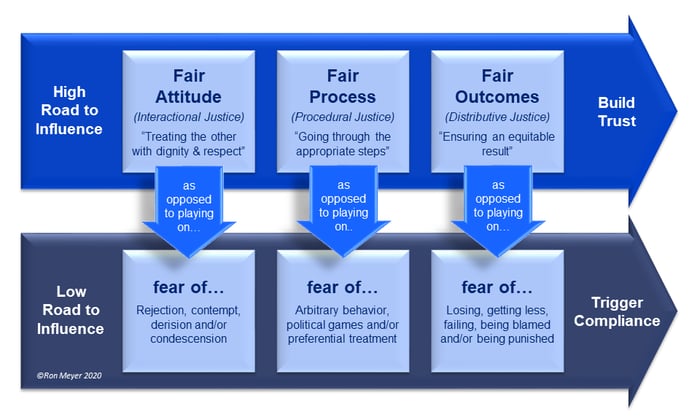What determines whether people feel I am treating them fairly?

Fairness is the quality of behaving in a reasonable and just manner. It is about treating others the right way. But whether these others judge the behavior to be fair depends on their perception of what happened. In other words, fairness is in the eye of the beholder – you might think you behaved fairly, but that doesn’t mean others experienced it as such.
To get people to follow willingly, leaders need to build trust, which hinges on being believed to be fair. If people don’t have faith in the leader’s fairness, they will fear unjust treatment, which might still compel them to follow but in a compliant, not an engaged, manner.
Conceptual model
The Leadership Fairness Model distinguishes between two fundamentally different pathways to leadership – the fair and fear approaches. Being fair is the high road to leadership influence, as being just and reasonable builds people’s trust in the leader and makes them willing to be swayed. Playing on people’s fear, on the contrary, is the low road to leadership influence, as people might reluctantly comply but only to avoid undesirable consequences.
The model subsequently identifies three ways in which a leader can give people a sense of being treated fairly. These three types of fairness are complementary and can reinforce each other. They can be seen as the input (attitude), throughput (process) and output (outcome) of interaction between a leader and followers. Where leaders, intentionally or inadvertently, fail to behave in a fair manner, they will trigger a variety of fears in the people around them. The model suggests it is up to leaders to choose in which way they want to exert influence.
Key elements
The three types of fairness are the following:
- Fair attitude. Every interaction between a leader and a follower starts with the basic posture that the two adopt toward each other. When a leader approaches the follower with dignity and respect, this will be experienced as a recognition that the follower is valued as a human being. By expressing in word and deed that the other is accepted as a worthy individual, the leader signals “I acknowledge you as someone whose interests I will keep in mind”. Such a just way of relating to the other is also referred to as interaction justice.
When a leader fails to embrace others as respected counterparts, they can feel irrelevant, rejected or looked down upon with contempt, derision and/or condescension.
- Fair process. While fairness begins by approaching the other with respect, it needs to be followed up by treating the other in a reasonable and equitable way. When a leader goes through the steps of due process, this will be experienced as an honest and legitimate handling of a situation. By following the appropriate procedures in a secure fashion, the leader signals “you can count on me to deal with you in a balanced, sensible and ethical manner”. For this reason, this type of fairness is also called procedural justice.
When a leader fails to follow due process, others might feel at the mercy of his/her arbitrary whims, as pawns in his/her political games and/or as victims of his/her partisanship.
- Fair outcomes. A sense of fairness also depends on whether the results of the interactions between the leader and the follower are shared in a just manner. Whether a process has a favorable or undesirable outcome, for followers it is of critical importance that these results are allocated to the various stakeholders equitably. By dividing them among the different participants in an even-handed and appropriate way, the leader signals “you can have confidence that I will distribute the outcomes correctly”. For this reason, this type of fairness is also called distributive justice.
When a leader fails to share the benefits and losses fittingly, others can feel they are losing out or getting less, and/or fear being branded a failure, given the blame and punished.
Key Insights
- Fair and fear as the two approaches to leadership. Leadership is the ability to influence others to move in a certain direction, and there are two types of influence; being fair builds trust and sways people to follow voluntarily, while fear triggers people to follow compliantly.
- Fairness is the high road to leadership. Acting fairly is a key ingredient of building trust between the leader and the followers. It generally takes long and requires considerable effort, but it is the route to winning hearts and minds and achieving lasting engagement.
- Three types of fairness. Leaders can be fair in the way they relate to others (fair attitude), in the way they deal with others (fair process) and in the way they share results with others (fair outcomes). The three forms are complementary and can reinforce each other.
- Fairness is in the eye of the beholder. While leaders might think they are behaving fairly, the only thing that matters to have influence is how the follower experiences a leader’s behavior. Therefore, leaders need to ensure that they are seen to be fair.
- Fear also works. But there is also a low road to leadership, which plays on fear to get people to comply. This approach works and is used by many, both intentionally and inadvertently. It is up to each leader to consciously choose which road they wish to take.
This blog is part of a series, if you want to see all the blogs, then click below:




